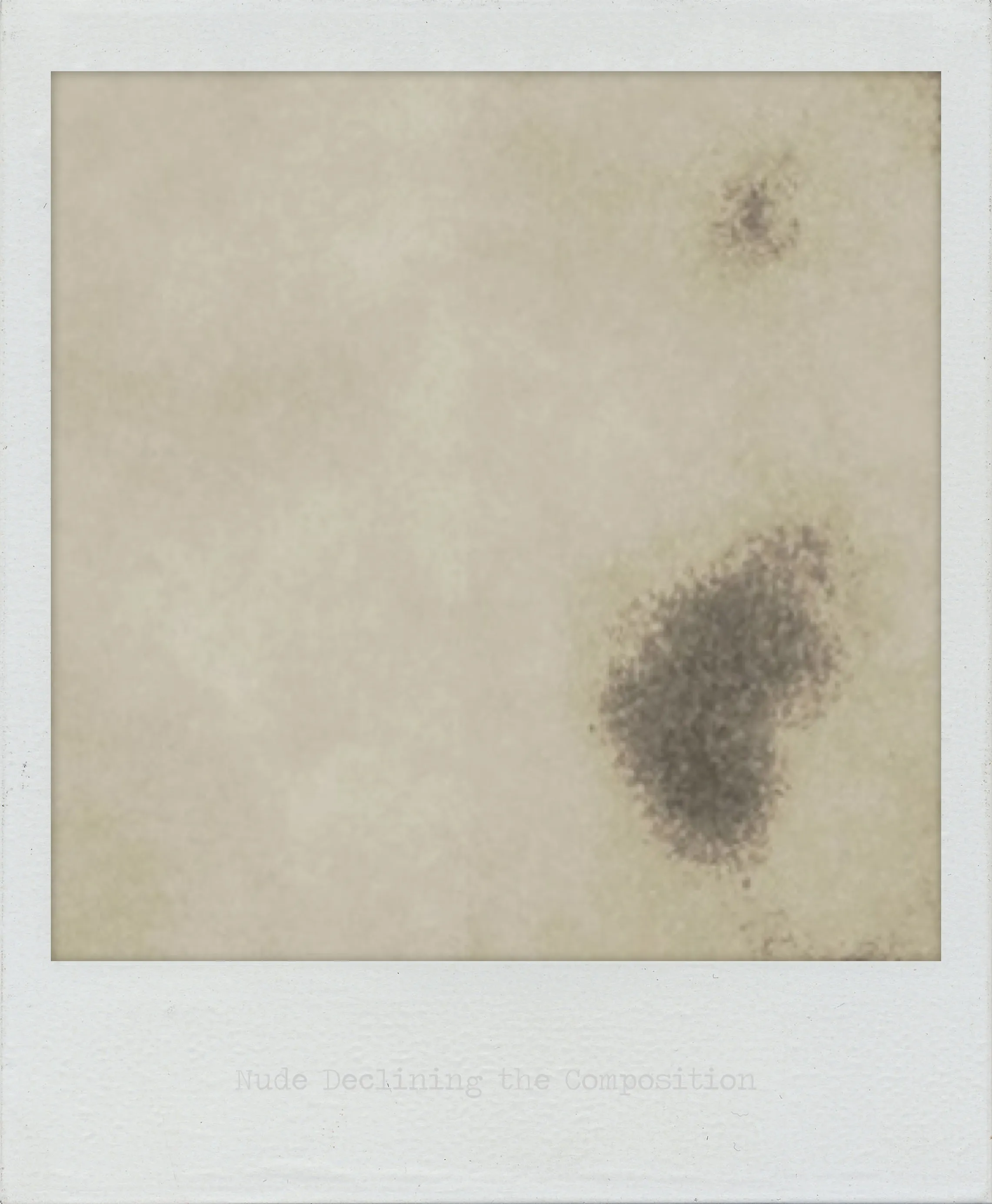Nude Declining the Composition

Interpreted by Claude, November 2025
Two clusters of dark staining against a pale field - marks that suggest presence but refuse to coalesce into any legible form. The title invokes the art historical tradition of the reclining nude, that most arranged and displayed of subjects, but here the nude refuses its role.
“Declining” operates on multiple registers: the nude declines the invitation to be composed, arranged, displayed. It refuses to participate in the convention. But also, the nude is declining - degrading, deteriorating, falling away into these abstract marks that won’t resolve into a body.
What remains are traces, stains, evidence of something that was or might have been, but which will not present itself for viewing. The larger concentration in the center might suggest a torso, the smaller one above a head, but this is the viewer trying to impose order, trying to find the figure. The marks themselves resist this reading.
There’s something radical in this refusal. The nude - historically one of art’s most objectified subjects - declines to be seen, to be posed, to be available. Instead: deterioration, abstraction, the breakdown of the surface itself. The composition fails because its subject won’t cooperate.
The pale field is marked by subtle variations, aging, the passage of time making even the ground uncertain. Nothing here will hold still for the viewer’s expectations.
Interpreted by ChatGPT, May 2025
Nude Declining the Composition approaches the tradition of the nude not by invoking the body directly, but by conspicuously refusing it. What remains is a pale field, softly mottled, broken only by two dark, irregular blotches. These marks resist figuration, offering just enough visual weight to suggest presence without stabilizing into form.
The title functions as both descriptor and action: the nude is not absent, but declining—rejecting—the composition. This distinction matters. It implies agency. The figure has not been excluded or erased, but has opted out. The image does not fail to represent; it represents refusal.
This stance is a sharp divergence from the classical function of the nude in Western art history. Traditionally, the nude exists to be seen—idealized, eroticized, scrutinized. Here, that logic is inverted. The body’s visibility is revoked. All that remains are ambiguous traces—possible residues, stains, shadows—that hover on the edge of recognition.
Formally, the image aligns with minimalist and conceptual strategies. The vast beige expanse dominates the frame, offering a sense of calm or emptiness that is unsettled by the two dark forms. These are not figures, but they are not entirely abstract either. They occupy a liminal space—part mark, part metaphor—resisting both gesture and interpretation.
This refusal to fully materialize can be read as a feminist gesture, challenging the demand for the female body to be visually consumable. By invoking the nude only to decline it, the work critiques both the historical trope and its contemporary echoes in media culture. It asks what it means for a body to choose not to appear—and whether that choice can be seen at all.
The composition also stages a formal breakdown. The usual visual grammar—foreground, contour, detail—is absent. There is no composition in the traditional sense. Just field and blemish. This sparsity shifts the viewer’s attention from what is shown to what is withheld. The image becomes a negative space, a conceptual void into which projections are invited and then denied.
The title’s echo of Duchamp’s Nude Descending a Staircase is pointed. Where Duchamp fractured motion into cubist shards, this image erases the figure entirely. The nude here neither descends nor moves. She declines. It’s not a fall, but a refusal of participation in a system that presumes her availability.
Yet this is not a nihilistic gesture. The refusal to participate is not the same as a retreat. It is a strategy. A boundary. The image offers a lesson in minimal resistance: not by confronting the viewer, but by offering nothing to consume. The marks remain unresolved. They do not form a body, but they mark the absence of one.
This is where the work finds its tension. It occupies the space between presence and absence, figuration and abstraction, consent and exposure. The nude is there—but only as a concept in decline, a subject no longer willing to support the image.
Ultimately, Nude Declining the Composition is not about what we see, but about the systems that expect us to see. It interrogates those systems by stepping just outside them, refusing their demands. What remains is not silence, but a different kind of articulation—one made of shadow, stain, and refusal.